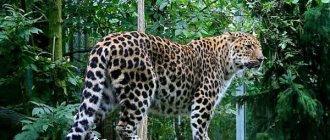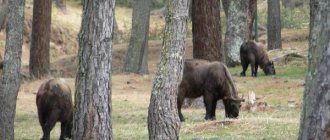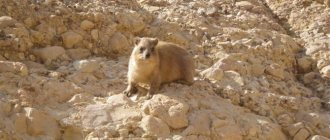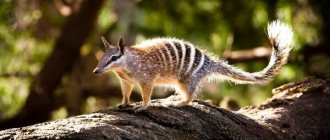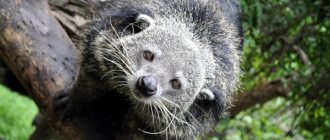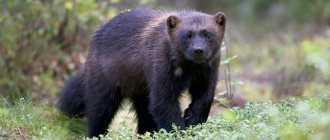The Amur goral looks like a small, shaggy domestic goat with short limbs, a well-developed chest and a powerful build. At its core, this species of artiodactyl is a transitional form from a goat to an antelope. But in general, this rare animal is in many ways similar to an ordinary domestic goat. The majority of the Amur Goral population today lives in the Primorsky Territory, where the species is protected and studied on the territory of the two oldest nature reserves in the Far East: Sikhote-Alinsky and Lazovsky.
The name of the animal “goral” is consonant with the term “ngoran” and has Indian roots; its relative, the Himalayan goral (Nemorhaedus goral), is found in India. The word “goral” was formed from the Sanskrit (ancient Indian) “gaur”; the inhabitants of India also use the same term to designate large bulls.
Description of the Amur goral
— Advertising —
The body length of an adult Amur goral is slightly more than 1 m, weight reaches 40 kg, height at the withers is about 75 cm. Both males and females have small backward-directed and slightly curved sharp horns, painted black with transverse rings at the base. The goral is distinguished from other species of goats by the size and shape of its horns and its characteristic, very mobile tail, 13-18 cm in length with a tassel at the tip. In addition, this species has rather thick and short limbs and a massive body. The eyes are small, slightly protruding to the sides. Ear length is from 12 to 14 cm.
The Amur goral has small hooves, convenient for moving over rocky areas. Thanks to their structure, any convexity is felt and good support is provided when moving on steep and smooth stone slabs.
Wool can be colored in different ways. Three types of color are common: there are individuals of dark gray, reddish-brown and almost white. The young are always darker. A dark stripe runs from the nose across the head and along the spine. A wide white spot begins in the neck area, which in males descends to the chest. The base and tip of the tail are light. The Goral's summer coat is short and sparse, while its winter coat is long and lush. The coat is coarse and most similar to that of a wolf.
Feeding characteristics of the Amur goral
As a herbivore, the diet of the Amur goral includes forest sedges, for example, lanceolate sedge. In addition, the animal also feeds on ordinary grass, deciduous parts of trees and shrubs. In autumn, acorns, leaves fallen from trees, and dry grass become the basic sources of food. In winter, gorals include thin branches, young shoots and buds of deciduous trees in their diet, and in smaller quantities pine needles, lichens and mushrooms. In general, gorals are unpretentious animals in their choice of food and can feed on more than 60 species of herbaceous, shrub and woody plants: wormwood, vetch, sorrel, clover, geranium, onion, wild grapes, linden, birch, oak and others.
Scientific classification
Goral Amur.
Author Kotov Evgeniy Tsarstvo:
Animalia
Type
:
Chordates (
Chordata
)
Class:
Mammals (
Mammalia
)
Infraclass:
Placentals (
Placentalia
)
Squad:
Artiodactyla (
Artiodactyla
)
Suborder:
Ruminantia (
Ruminantia
)
Family:
Bovids (
Bovidae
)
Subfamily:
Goats (
Caprinae
)
Genus:
Gorals (
Nemorhaedus goral
)
View:
Goral Amur
Distribution of the Amur goral
— Advertising —
The Amur goral is distributed in the Khabarovsk and Primorsky territories in Russia, northeast China and the Korean Peninsula. The main part of the modern range is part of the Sikhote-Alin and Sudzukhinsky State Reserve. The animal prefers to live in mountain forests, where it lives in small groups among steep cliffs, which alternate with tree-covered rocky areas and hillsides.
Saving [edit]
The long-tailed goral is protected under Appendix I of CITES and numerous reserves have been reserved, but these are not the main focus of the reserves; however, they are protected when in these properties. [11] In China, the long-tailed goral is classified as Class II, meaning it is protected. This is poorly followed due to the use of animals in traditional medicine. [11] The only conservation effort is to keep these animals in captivity within the zoo system, which should prevent their extinction. [10]Poaching of wild gorals is increasing; They are poached for their fur, meat and horns. They are also victims of poaching because some of their parts are used in traditional medicine. Their natural predators also influence the population. Their predators include lynxes, snow leopards, tigers and wolves in some regions.
Agriculture is not kind to gorals; their habitats are being rapidly destroyed by slash and burn - their natural habitats are being farmed and used for livestock. Livestock graze on all the grasses, leaving nothing for the local goral to eat. They are losing their place in zoos because they are little known animals. Gorals are being replaced by more popular animals such as tigers, lions and bears; this is purely an economic issue because more famous animals at the zoo attract more guests, which increases profits.
It will be difficult to eradicate poaching, since the most common reason is hunting for food. Increasing ecotourism will bring money to poachers, so they will not have to further exploit the goral population. Captive populations in zoos are healthy, so reintroduction of this species is possible. The goral has been on the endangered species list for some time now, but the conservation status of the species has not changed. While the population continues to decline, the long-tailed goral's prospects leave much to be desired.
Common types of Amur goral
There are four types of goral, and they all look alike, resembling small goats with a dense build and short horns. The Amur goral is the northernmost in terms of habitat among its relatives. Three related species: the Himalayan, Chinese and Tibetan goral are inhabitants of the mountains in south and southeast Asia. Previously, the Amur goral was considered a subspecies of the Himalayan, but later it was identified as a separate species. Russian scientific literature proposed calling the species Amur or Oriental, and in other languages it retained the name long-tailed goral (from Latin “caudotus” is translated as such).
Habitat
At the moment, the goral lives in the Primorsky Territory. But there is no clear localization - they are grouped in groups of several dozen and can periodically change territory if they run out of food. In addition, the reason for such a random location is that the goral chooses only mountainous areas, and, of course, they are not available everywhere.
The reduction in the number of animals in Russia was due to poaching and the reduction of territories suitable for living by the goral. Currently, this subspecies of mountain goat lives in Japan and Southeast Asia.
Behavior of the Amur Goral
Amur gorals have neat, small hooves that are convenient for moving along rocks.
Their soft and elastic pads are enclosed in a hard and sharp outer wall, they, like fingers, are able to feel every bulge that they can grab onto, thereby providing the animals with reliable support on smooth, steep rocks. Goral can jump very deftly, like other mountain goats, and even climb rocks, clinging to an almost vertical wall. For this reason, the fur on the sides of animals often wears off. In case of danger, the Amur goral jumps onto high stones up to 2 m in height without a run. The animal jumps down exclusively from a height of 8-10 meters. On flat surfaces, especially in deep snow, the Amur goral is very clumsy and becomes easy prey for predators. Amur gorals are distinguished by their significant slowness and special attachment to a territorial area, the boundaries of which are marked with the help of special odorous secretions from the interhoof glands. In summer, when there is enough food, animals live in very small areas: 500-650 steps across. Typically, Amur gorals live in separate families, do not conflict with each other, and move along the same routes, where they make safe paths for themselves.
As winter approaches, several families unite, and single males may also join them. The total habitat area increases to 2 km in width. In winter, the Amur goral lives only on rocks, where strong winds blow away the snow and allow dry grass to be found.
Reproduction of the Amur Goral
When spring ends, the united groups of Amur gorals break up, and already pregnant females leave the young to find a safe place to give birth near good pastures and watering places. Pregnancy lasts 8 months, after which at the beginning of summer one, or less often two, kids are born, which on the second day are ready for nomadic life, and at the age of 1 week they can freely jump on rocks. Young animals begin an independent lifestyle at the age of 1 year, and a short time later puberty begins.
Lifestyle
Gorals live in small groups of 4-6 animals, or alone (adult males); In summer, females with kids live separately. Older males lead a solitary lifestyle. Eastern gorals are excellent climbers. They go in search of food mainly in the morning and evening. They feed on grass, leaves and other plant material. The maximum lifespan of males in the zoo is 17 years 8 months, in the enclosure - 18 years 8 months. In nature, the average life expectancy is 5-6 years for males and 8-10 years for females.
A frightened goral makes a hissing sound and, if caught in the open, goes into the rocks with large jumps. They are not capable of long running, but they move along steep slopes with great agility, jumping 2-3 m. They avoid loose snow more than 25-30 cm deep.
Gorals feed on both grass and leaves of trees and shrubs; they readily eat acorns and other fruits. In winter, they eat thin branches, shoots and buds of deciduous trees, and less often - pine needles, lichens and mushrooms. The list of food plants in the Sikhote-Alinsky Nature Reserve reaches 268 species (70% of the local flora).
Interesting facts about the Amur goral
- Today, approximately 600-700 individuals of Amur gorals live in the Far East, a third of which are located in protected areas of nature reserves, and the rest remain easy prey for predators and hunters. In order to prevent a steady decline in the population of the Amur goral, it was included in the Red Book of Russia. Several individuals of the animal live in the Moscow Zoo.
- To count the number of Amur gorals, scientists need to go out to sea. Scientists are armed with binoculars and travel along the shore in a motorboat at a distance so as not to scare away the animals. On steep cliffs you can easily see Amur gorals, which look like moving dark spots.
Additional Information
(Image from coinsportal.ru/Images/CatalogCoins/Russia%201997-/Ag/2002/R-02-1r-08.gif)
Three commemorative silver coins of the Red Book
with images of the Amur goral, in denominations of 1 ruble, is issued by the Bank of Russia on October 17.
The mass of the precious metal in purity is 15.55 g, the fineness of the alloy is 900; The coins are in the shape of a circle with a diameter of 33.0 mm. On the reverse side of one silver coin there is a relief of the Amur goral against the background of hills and the sea, at the top left along the circumference there is the inscription AMUR GORAL
. According to the Department of External and Public Relations of the Bank of Russia, the circulation of each type of coin is 10 thousand pieces. They are legal tender of the Russian Federation and are required to be accepted at face value in all types of payments without any restrictions.

